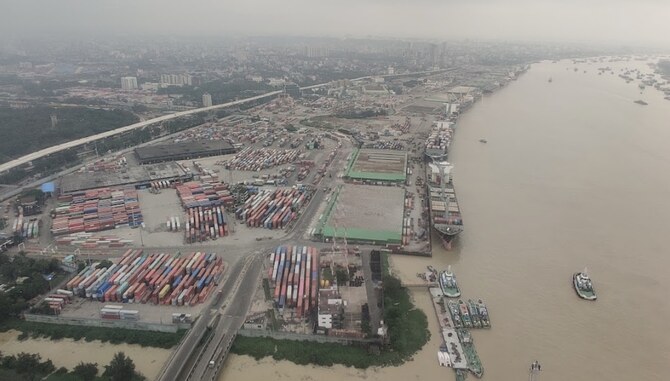ORANGE, United States: Emergency workers in storm-hit southeast Texas on Thursday staged dramatic rescues by air and water in towns that were until now cut off by raging floodwaters unleashed by monster storm Harvey, which finally started to move inland.
Nearly a week after the storm smashed into the US Gulf Coast as a Category Four hurricane, thousands of rescuers and civilians eager to help battled difficult conditions to reach victims of the unprecedented flooding.
“We felt we’d be alright. We were wrong,” said Lonnie Givens, who refused to evacuate their one-story home in the town of Orange. Now, he and wife Missy have about four inches (10 centimeters) of water in the house and no power.
“We really got nowhere to go,” Givens said.
The story told by Givens held for many others in Texas towns inundated by days of torrential rains, with highways still submerged and homes destroyed.
A hospital in the hard-hit town of Beaumont was forced to evacuate its patients — nearly 200 people — when the town’s water supply went down.
So far, Harvey has been blamed for at least 38 deaths and tens of billions of dollars of damage.
“We are still in response mode and that means life saving,” Homeland Security adviser Tom Bossert told a White House briefing. “There are still people up to their waists in water.”
Mayor @sylvesterturner Chief @artacevedo & HFD Chief Pena board HPD helicopter to survey Houston https://t.co/IWwpkG7GUC
— Houston Police (@houstonpolice) August 31, 2017
Bossert estimated that 100,000 homes had been affected by flooding — some with eight feet (2.4 meters) of water or more — and said the White House would be asking Congress for emergency funds.
On Thursday, the lack of power to refrigeration units at a chemical plant in Crosby sparked twin explosions and a fire that spewed black smoke, but authorities said the danger was limited.
There was a bit of good news — in Houston, America’s fourth-largest city, some of the 2.3 million residents got relief as the raging waters receded.
“We’re going to stay with you until we bring southeast Texas back to being bigger and better than ever before,” said US Vice President Mike Pence in the town of Rockport, which sustained major damage when Harvey made landfall.
President Donald Trump, who visited Texas on Tuesday, will return to the state on Saturday — and may also visit Louisiana, which has also seen serious flooding.
In Orange, a National Guard truck stopped to rescue three people near the Givens home.
“They are life savers!” shouted one of the women, after she waded out of knee-deep water.
In Beaumont, to the northwest of the coastal city of Port Arthur, the water system was down.
Brock Long, the head of the US Federal Emergency Management Agency (FEMA), said his agency was working with the state and the military to open water distribution points for those affected.
Indeed, military trucks fanned out, loaded up with bottled water, military backpacks and personnel ready to help.
The breakdown of the water system forced the evacuation of nearly 200 patients from a Beaumont hospital, some by military helicopters.
“It is very, very organized,” hospital spokeswoman Mary Poole said. “We’ve practiced this many times before.”
“We’re trying to keep them as close as possible,” she said of the evacuated patients. “Part of the healing process is to be with your family.”
Early in the day, a pair of explosions rocked a flooded chemical plant in Crosby, a town of around 3,000 people some 25 miles (40 kilometers) northeast of Houston, sending a plume of smoke into the air.
Officials ordered residents living within 1.5 miles of the facility to evacuate amid concerns about the fumes emanating from the facility, which produces organic peroxides — compounds that can combust if not cooled to the right temperature.
The company said the chemicals could cause eye, skin or respiratory irritation as well as nausea, drowsiness or dizziness, and urged nearby residents to turn off their air conditioners to avoid possible smoke exposure.
The Environmental Protection Agency said it was reviewing data from an aircraft that surveyed the scene and had no indication that dangerous amounts of toxic materials have been released.
“We believe along with the local authorities that we’ve moved everyone out of harm’s way, and that no one is in danger,” Richard Rennard, a senior executive for French plant owner Arkema, told a news conference.
Fifteen sheriff’s deputies who responded to the fire were briefly hospitalized.
Crosby resident Lane Averett, 59, told AFP at a church shelter in the town that he was worried about the animals he had left behind.
“I had to leave because of the plant,” Averett said.
“I got a dog and three cats, and a calf shut up in the trailer where they can’t get no water or feed or nothing,” he said. “They need to get some water and feed today.”
In Louisiana, authorities scrambled to safeguard their state from Harvey, whose onslaught evoked painful memories of Hurricane Katrina’s deadly strike 12 years ago — but New Orleans escaped with minimal rain.
So far, parts of Texas have seen more than 50 inches (1.27 meters) of rain, while in Louisiana, the total neared 24 inches.
More than 30,000 people have found refuge in shelters across Texas, from the giant Houston convention center to small churches, according to FEMA.
In Houston, where Mayor Sylvester Turner issued a nighttime curfew to aid search efforts and thwart potential looting, the two major airports have reopened on a limited basis, signaling a slow return to normality.
In Texas, the storm damage is staggering — Enki Research put its “best estimate” at between $48 billion and $75 billion.
























